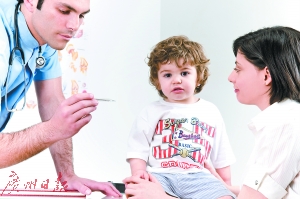When the season changes, infants are most likely to catch cold and have fever. Xiaoxuan (a pseudonym), a 2-year-old boy in Guangzhou, was recently "hit". However, to the surprise of his parents, Xiaoxuan had a fever for less than a day and suddenly suffered from loss of consciousness, turning white eyes, shaking limbs, foaming at the mouth and other symptoms. The reporter learned from the emergency department of Sun Yat sen Memorial Hospital of Sun Yat sen University in the south hospital that it is not uncommon for children from half to five years old to have febrile convulsions like Xiao Xuan. The doctor reminded that if parents, especially fathers, had a history of febrile convulsions when they were young, they should be careful that their children would repeat the same mistakes.
Baby has high fever and convulsions. Dad barefoot holds baby in emergency
"I thought that the baby was just suffering from a common cold as usual, but who knew he would twitch!" In the emergency department, Xuan dad, barefoot, carried the baby to the hospital for emergency treatment, panicked. According to the doctor of the emergency department who received the diagnosis, Xiao Xuan's face became cyanotic due to the suffocation caused by the careless choking of the secretion into the respiratory tract, and there was a critical situation that the blood oxygen saturation dropped sharply. The medical staff took measures in time. Xiaoxuan stopped twitching and gradually regained consciousness, and her purple face soon turned red.
The doctor inquired and learned that this was Xiaoxuan's first fever and convulsions. Not surprisingly, Xiao Xuan's father had fever and convulsions when he was young.
Babies under 5 years old are prone to convulsion within 24 hours of fever
According to Dr. Chen Xiaoyu from the Department of Pediatric Neuroendocrinology of Sun Yat sen Memorial Hospital of Sun Yat sen University, Xiao Xuan's condition belongs to febrile convulsion. Febrile convulsion is an abnormal discharge of the brain caused by fever. The symptom is what we often call convulsion. Its incidence rate can reach 2% to 3%. It usually occurs between 6 months and 5 years old, usually within 24 hours after fever.
Febrile convulsions can be divided into simple febrile convulsions and complex febrile convulsions. They are different in attack time, frequency, etiology and harm.
Nearly 80% of children with febrile convulsions belong to the simple type. The child shows a generalized grand mal attack, that is, his eyes turn up or stare to one side, his teeth close or his mouth foam, his hands clench and flex, or his limbs have tonic clonus, and his consciousness is lost and he cannot breathe. This attack lasts for a short time, mostly within 15 minutes, and does not recur within 24 hours. There is no sequela after the attack.
Complex febrile convulsions accounted for 10%~20%. The child presents with focal attacks, which can occur many times within 24 hours or for a long time, lasting for 15~30 minutes. After the attack, there may be nervous system abnormalities. The pathogenesis of febrile convulsion is still unclear. It is currently believed that it is related to the immature development of children's nervous system and has obvious familial genetic tendency.
Fever convulsion does not equal epilepsy
Many parents worry that the brain development will be affected after the child has febrile convulsions, and even think that febrile convulsions are equal to epilepsy. Actually not.
Li Dongfang, deputy chief physician of the Department of Pediatric Neuroendocrine, Sun Yat sen Memorial Hospital, Sun Yat sen University, further introduced that most simple febrile convulsions have a good prognosis and will not cause brain damage.
Convulsions that occur repeatedly for a long time, such as status convulsions and complex febrile convulsions with more frequent seizures, may cause damage to brain functions, such as learning and memory. Only about 1.5% of simple convulsions and about 7%~12% of complex febrile convulsions may develop into epilepsy and require long-term medication. In general, the probability of epilepsy secondary to febrile convulsion is very low.
Li Dongfang suggested that parents should treat febrile convulsions rationally. Febrile convulsions are one of the most common emergencies in children. Once convulsions occur, calm down. Under the guidance of doctors, actively find out the cause of fever and eliminate other factors that cause convulsions. Of course, for children with high risk of recurrence or possible secondary epilepsy, it is recommended to carry out relevant laboratory and imaging examinations under the guidance of doctors, and develop further treatment plans.
Let the child lie on his side after convulsion
Chen Xiaoyu pointed out that most of the febrile convulsions are temporary self limited attacks, and parents should calm down to avoid unnecessary damage caused by panic. Most children's convulsions end within 2-3 minutes. Parents must be calm when their children have convulsions. Since many families do not have emergency medicine such as oxygen and valium, the best way for parents to deal with it is to place the child in a side position, and press the child at the same time. After the child's convulsion is completed, first pack up the necessary items, and then go to the hospital.
If the convulsion lasts for 5 minutes and still does not subside, or the child is unconscious after the attack, it is necessary to seek medical advice as soon as possible.

